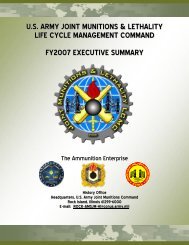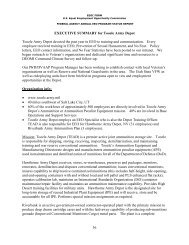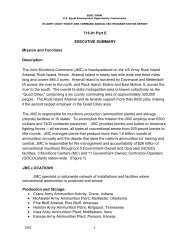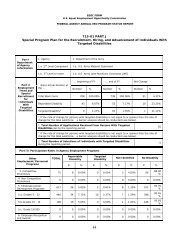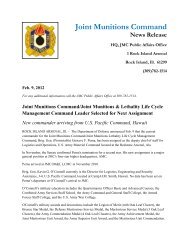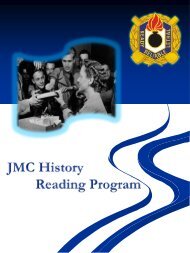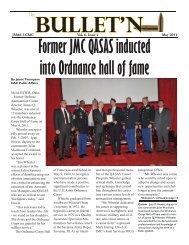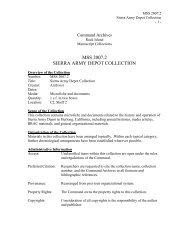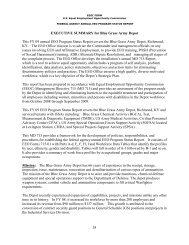History of the Ammunition Industrial Base - JMC - U.S. Army
History of the Ammunition Industrial Base - JMC - U.S. Army
History of the Ammunition Industrial Base - JMC - U.S. Army
You also want an ePaper? Increase the reach of your titles
YUMPU automatically turns print PDFs into web optimized ePapers that Google loves.
missions, <strong>the</strong> organic ammunition industrial base decreased to eight production plants, two<br />
munitions centers, and three depots. 169<br />
Sustaining <strong>the</strong> <strong>Industrial</strong> <strong>Base</strong> in <strong>the</strong> 21 st Century<br />
The <strong>Army</strong> has made strides in transforming into a lighter, more lethal land force. It is no<br />
surprise that <strong>the</strong> current industrial base is <strong>the</strong> smallest it has been because <strong>of</strong> underutilization,<br />
low funding, better stockpile management and smaller requirements. At <strong>the</strong> working level <strong>of</strong><br />
ammunition management, several efforts have been initiated and put in place to better assess<br />
readiness, manage stockpiles, and improve plant utilitization; all <strong>of</strong> which contribute to <strong>the</strong><br />
health <strong>of</strong> <strong>the</strong> industrial base despite its smaller size. At <strong>JMC</strong> several <strong>of</strong> <strong>the</strong> following initiatives<br />
have enabled <strong>the</strong> ammunition community to meet and solve ammunition shortages, readiness,<br />
and supply ongoing contingency operations.<br />
The Munitions Readiness Report (MRR)<br />
The Munitions Readiness Report (MRR) system, designed subsequent to <strong>the</strong> September<br />
2001 terrorist attack, provides major elements <strong>of</strong> <strong>the</strong> <strong>Army</strong> with a common methodology for<br />
assessing munitions readiness. The Munitions Readiness Report (MRR) measures ammunition<br />
stockpile readiness by assessing <strong>the</strong> inventory and condition code <strong>of</strong> ammunition. However, <strong>the</strong><br />
<strong>Army</strong> has not always assessed <strong>the</strong> size <strong>of</strong> <strong>the</strong> stockpile in terms <strong>of</strong> readiness. Two days after <strong>the</strong><br />
September 11 th, 2001 attacks, Commander <strong>of</strong> <strong>the</strong> Operations Support Command (OSC), Major<br />
General Wade H. McManus, Jr. flew to Washington DC to brief <strong>the</strong> Chief <strong>of</strong> Staff <strong>of</strong> <strong>the</strong> <strong>Army</strong><br />
on <strong>the</strong> readiness <strong>of</strong> <strong>the</strong> ammunition stockpile. His news was not good and revealed longstanding<br />
issues in <strong>the</strong> funding and reporting <strong>of</strong> <strong>the</strong> stockpile. In <strong>the</strong> past DA tracked <strong>the</strong> stockpile based<br />
primarily on <strong>the</strong> number <strong>of</strong> tons available and location. However, funding gaps since 1990 had<br />
reduced <strong>the</strong> amount <strong>of</strong> surveillance and maintenance required to keep stocks fully ready for<br />
issue. This metric did not accurately reflect <strong>the</strong> quantity <strong>of</strong> ammunition that was not in an<br />
issueable condition. In 2001, much <strong>of</strong> <strong>the</strong> ammunition stockpile was ei<strong>the</strong>r in poor or unknown<br />
condition because funding shortfalls had precluded surveillance inspections and maintenance.<br />
Reporting systems assumed that if items were in <strong>the</strong> stockpile, and not coded for<br />
demilitarization, <strong>the</strong>y could be issued. While on hand, many stocks required maintenance and<br />
<strong>the</strong> reporting systems did not reflect that status ei<strong>the</strong>r.<br />
OSC and its predecessor commands had been warning about <strong>the</strong> condition <strong>of</strong> <strong>the</strong><br />
stockpile for many years, but tightening budgets made it impossible to keep up with slowly<br />
deteriorating ammunition. The ammunition base needed time and funding to keep shipping<br />
ammunition to <strong>the</strong> joint forces, and <strong>the</strong> lack <strong>of</strong> both presented an immediate problem. 170<br />
Problems stemmed back to <strong>the</strong> 1980s and <strong>the</strong>n became significantly larger with <strong>the</strong> return<br />
<strong>of</strong> stocks from SWA after Operations Desert Shield/Desert Storm. Most <strong>of</strong> <strong>the</strong> stocks<br />
returned from SWA did not receive final inspections. Temporary Desert Storm condition<br />
codes, which were slated to be changed to standard codes after <strong>the</strong> ammunition had been<br />
inspected, were still in <strong>the</strong> database in 2001.<br />
169 There are excellent online resources regarding prior BRAC round closures and realignments. See<br />
http://www.defenselink.mil/brac/priorbracs.html; http://www.hqda.army.mil/acsim/brac/braco.htm; for present<br />
and prior information on BRAC.<br />
170<br />
AFSC/<strong>JMC</strong> <strong>History</strong> Office. End <strong>of</strong> Career Oral <strong>History</strong> Interview, Colonel C. Redding Hobby. (November<br />
2002), 14-15.<br />
56



